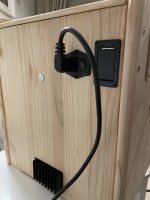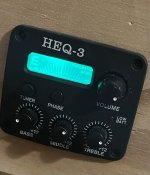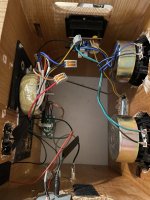How would I earth this then?That looks like a short between In- and ground. The buck converter does not have a symmetrical input/output.
That does not look like a symmetrical supply ie +-9volts if that is what you need? And from the pic (you need to ohm measure to confirm) you have shorted In-and ground as tsz pointed out which btw would give your toroid a hard time.
The converter in the latest photos seems to expect DC as input.
The posts #9 and #10 show a different board capable of handling AC input.
The posts #9 and #10 show a different board capable of handling AC input.
If you only need plus 9v (and not both + and -9 volts) you should ground it at IN- however you need to understand/share what the low voltage part of the amp looks like before we can advice if it will work or not.How would I earth this then?
Yes, I have an ac/dc power board after the transformer. The converter in the latter picture steps the dc voltage down to 9vdc to power a preamp. However, it’s looking more likely that the buck is at least part of the problem. Once I have the transformer fused correctly, I shall test with and without the buck. The preamp can be powered by a battery, but I was hoping to avoid this so took a buck from the ac/dc converter as a second power supply for the addition of the preamp.The converter in the latest photos seems to expect DC as input.
The posts #9 and #10 show a different board capable of handling AC input.
Two earlier posts are telling you that you are shorting - (minus voltage) to ground (that is visible also on your photos). What makes it so difficult to understand this?Once I have the transformer fused correctly, I shall test with and without the buck.
Nothing. There’s just lots of possibilities here and lots of advice which I am taking on board and trying to assimilate.Two earlier posts are telling you that you are shorting - (minus voltage) to ground (that is visible also on your photos). What makes it so difficult to understand this?
I’m very grateful to this forum and have learnt lots already. Would you happen to be able to advise on how to ground the buck?
I think I’ll install the fuse, do away with the buck for now and get the amp working, then start a new post re how to power up the preamp. Thanks for all the help 😊If you only need plus 9v (and not both + and -9 volts) you should ground it at IN- however you need to understand/share what the low voltage part of the amp looks like before we can advice if it will work or not.
It is clear from the photo in post #36 that your buck converter connects IN- to OUT- and the place you connected "ground". Connecting the raw V- to IN- and ground to the hole for an alternate connector for (IN+ and) IN- shorts out V-. You have a LM2596 "simple switcher" buck converter, which is a positive ONLY buck converter and it's IN-/OUT- should be connected to ground only, not to V-. If you need a negative -9V for the preamp, then you need another regulator/buck converter, and you cannot use another positive buck converter. The most common solution is a LM79xx or a LM337. A readymade module that supplies both +9 and -9 would be something like this:
https://www.amazon.com/KNACRO-Adjus...7&qid=1704752235&sprefix=lm337,aps,132&sr=8-4

https://www.amazon.com/KNACRO-Adjus...7&qid=1704752235&sprefix=lm337,aps,132&sr=8-4
From the looks of the transformer specs you might be putting the two wires labeled 0 together to the ground input on the pc board. This is wrong! Connect the 0 of the first winding to AC input, connect the other wire from that secondary to the 0 of the other secondary and put that to the ground input on the pc board. The last open wire goes to the other AC input on the pc board. That means yellow and black together to ground, and red and orange to AC.
To simplify what steveu stated. The buck board uses only the DC+ and 0V from the power supply board and puts out +9VDC and 0V, as needed by the pre-amp. Don't connect DC- to the buck board. To "ground the buck", connect 0V DC to the ground or minus connection of the buck board.
Rather than your single output buck module, you'll likely want a dual output 'SEPIC' buck-boost module like this : https://www.aliexpress.com/item/1005005048529153.html. It'll give you dual rails for your preamp board, assuming that's what it needs.
It occurred to me that "you cannot use another positive buck converter" is not exactly correct, but I see there are no switch-mode experts here that noticed. A positive buck regulator can be wired as a voltage inverter, converting the raw +V into -9V. But that would be a trick that I would not recommend to a beginner.
https://www.ti.com/lit/an/snva856b/snva856b.pdf?ts=1704721033136
In any case, the desire for a 9V supply implies that the preamp is a guitar pedal intended to run on a single 9V battery, which would not need a negative supply. However, the output from a circuit that runs on only 9V may not have enough output to drive a power amp. More information about the "preamp" would clear that up.
https://www.ti.com/lit/an/snva856b/snva856b.pdf?ts=1704721033136
In any case, the desire for a 9V supply implies that the preamp is a guitar pedal intended to run on a single 9V battery, which would not need a negative supply. However, the output from a circuit that runs on only 9V may not have enough output to drive a power amp. More information about the "preamp" would clear that up.
Last edited:
The fused IEC switch already has the fuse in the proper place, nothing else to add.Thanks for this 😊 If I got a fused IEC switch on the mains side, would that be the place to add the fuse, or should it come after the switch?
Thanks for this, really helpful. The preamp is actually an acoustic guitar preamp powered by a single 9v battery, which I wanted to use to shape the tone of my audio signal and to have volume control on the amp. Itself as well as on the guitar.It occurred to me that "you cannot use another positive buck converter" is not exactly correct, but I see there are no switch-mode experts here that noticed. A positive buck regulator can be wired as a voltage inverter, converting the raw +V into -9V. But that would be a trick that I would not recommend to a beginner.
https://www.ti.com/lit/an/snva856b/snva856b.pdf?ts=1704721033136
In any case, the desire for a 9V supply implies that the preamp is a guitar pedal intended to run on a single 9V battery, which would not need a negative supply. However, the output from a circuit that runs on only 9V may not have enough output to drive a power amp. More information about the "preamp" would clear that up.
Alnicov Guitar Pickup Auto Manual Tuning Mode EQ Tuner Guitar Preamp Equalizer https://amzn.eu/d/7v9MM6u
That should be fine as the power amp has an input capacitor. Drive the buck with 0v -+28v and ground it's output to Ov. The buck may not have a floating output and that arrangement should get round that and be ok even if it has.To simplify what steveu stated. The buck board uses only the DC+ and 0V from the power supply board and puts out +9VDC and 0V, as needed by the pre-amp. Don't connect DC- to the buck board. To "ground the buck", connect 0V DC to the ground or minus connection of the buck board.
While a fuse is a good idea something is taking a lot more current than it should. Best find out what is.
Sill no mention of what speaker arrangement is being used.
I'm using the cones and tweeter from this speaker:Sill no mention of what speaker arrangement is being used.
Tannoy Mercury mC B/EYE
| Power Handling (RMS): | 140 Watts |
| Frequency Response: | 70Hz - 20kHz |
| Sensitivity: | 90dB |
| Nominal Impedance: | 8 Ohms |
| Drivers: | 1 x 25mm soft dome 2 x 102mm paper cone |
| Dimensions: | 530 x 153 x 180mm (Width x Height x Depth) |
| Weight: | 6.7kg / 14.74lbs |
| Year: | 1998 - 2001 |
Well, thank you everyone!! I’ve now got my toy box practice amp working. It was indeed the naughty step down buck, I have since provided the 9v with a battery with an accessible battery box. Will try to add a reverb unit at a later date, but happy to be able to play for now!

Attachments
- Home
- Amplifiers
- Solid State
- Toroidal transformers burning up


